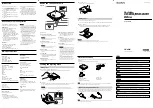
40 - 2
Bleeding
!
WARNING
Before proceeding with the bleeding procedure it is
important to ensure that the parking brake is engaged
and that one pair of wheels is blocked on both sides.
BRAK 1-2
!
WARNING
Use of incorrect fluid will cause serious damage to the
seals which could in turn cause brake failure.
BRAK 1-1
1
Fill the master cylinder reservoir with the correct fluid,
refer to Section 3
Fluids, Lubricants, Capacities and
Specifications
, and ensure that throughout the
bleeding process the level is not allowed to fall below
the MINIMUM mark.
2
Unlatch the pedals, and bleed each brake separately as
follows:
3
Right Hand Master Cylinder
a
Attach a tube to the right hand brake bleed screw
A
, ensuring that the free end of the tube is
immersed in fluid contained in a suitable container.
b
Open the brake bleed screw and apply full pedal
strokes of the right hand brake pedal until all air is
expelled.
c
Close the brake bleed screw with the pedal fully
depressed.
4
Left Hand Master Cylinder
a
Repeat procedure as for ' Right Hand Master
Cylinder' but use left hand bleed screw and pedal.
5
Bridge Pipe
a
Attach a tube to either the left or right hand brake
bleed screw, ensuring that the free end of the tube
is immersed in fluid contained in a suitable
container.
b
Make sure that the brake pedals are
locked
together.
Note:
4WS machines do not have dual pedal braking. These
machines are fitted with a single pedal that operates both
master cylinders.
c
Open the bleed screw and apply full pedal strokes
of the brake pedals until all air is expelled.
d
Close the bleed screw with the pedals fully
depressed.
6
Repeat the procedures as necessary.
7
Top up the reservoir to the full mark.
Section G
9803/3280
Section G
40 - 2
Issue 1
Service Brakes
S107710-1
A
5
















































